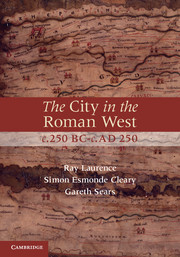Book contents
- Frontmatter
- Contents
- Illustrations
- Preface
- Introduction
- 1 The creation of an urban culture
- 2 Colonisation and the development of Roman urbanism
- 3 City foundation, government and urbanism
- 4 The reception of Roman urbanism in the West
- 5 Town planning, competition and the aesthetics of urbanism
- 6 Defining a new town: walls, streets and temples
- 7 Assembling the city 1: forum and basilica
- 8 Assembling the city 2: baths and urban life
- 9 Assembling the city 3: theatres and sacred space
- 10 Assembling the city 4: amphitheatres
- 11 The Roman city in c. AD 250: an urban legacy of empire?
- Bibliography
- Index
1 - The creation of an urban culture
Published online by Cambridge University Press: 05 June 2012
- Frontmatter
- Contents
- Illustrations
- Preface
- Introduction
- 1 The creation of an urban culture
- 2 Colonisation and the development of Roman urbanism
- 3 City foundation, government and urbanism
- 4 The reception of Roman urbanism in the West
- 5 Town planning, competition and the aesthetics of urbanism
- 6 Defining a new town: walls, streets and temples
- 7 Assembling the city 1: forum and basilica
- 8 Assembling the city 2: baths and urban life
- 9 Assembling the city 3: theatres and sacred space
- 10 Assembling the city 4: amphitheatres
- 11 The Roman city in c. AD 250: an urban legacy of empire?
- Bibliography
- Index
Summary
In trying to understand the Roman cities that appeared and developed in Italy and in the western provinces from 200 BC, we need to begin our discussion with an investigation of what the Romans thought urbanism was about, the forms it should take and what were they trying to make when they placed a new building in a city. To understand these concepts, we need to look at the developments within the city of Rome that were to alter the shape of that city, alongside a series of initiatives taken by the state in the coloniae (colonies) across Italy in the early second century BC, a period we see as crucial to the definition of a ‘Roman’ style of urban form and urban buildings (see fig.1.1). However, the developments in Rome and its coloniae did not occur in isolation. Contacts between Rome and the Hellenistic monarchies were intensifying from the late third century BC. This contact between the world of Rome and that of the eastern Mediterranean would ultimately result in the conquest of Macedonia and the incorporation of the cities of Classical Greece into the Roman Empire in 167 BC. The attitude of the Roman aristocracy towards Hellenism was complex, but can be illustrated by the fact that we find a number of senators sporting knowledge of the Greek language but refusing to use it in an official capacity. The Roman elite recognised that culturally the Hellenistic world had much to offer them and so drew on Hellenism and tended to absorb the culture, but deployed it selectively. Through diplomatic missions and warfare members of the Roman elite were exposed to a tradition of urbanism very different from that manifested at Rome, one marked by elements of formal planning, a range of public buildings and monuments and the use of elaborate architectural forms along with materials such as marble. This was particularly true of the leading political centres of the Hellenistic world such as Alexandria, Antioch and Pergamum, and of the great cultural centre of Athens, with all of which the Roman elite would have become progressively more familiar. The impact of contact with the East and Greek culture can be seen in those independent cities of Italy such as Pompeii (see fig.1.2) that were themselves developing or adopting new building types and styles of architecture. These would have influenced Rome’s view of the nature of urban life, whilst the acquisition of provinces, especially in the Iberian peninsula, provided new challenges to its definition. What we wish to examine in this first chapter is the development of an urban culture in the Roman West from about 200 BC down to the middle of the first century BC.
- Type
- Chapter
- Information
- The City in the Roman West, c.250 BC–c.AD 250 , pp. 12 - 36Publisher: Cambridge University PressPrint publication year: 2011



